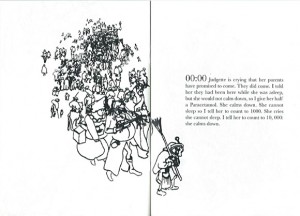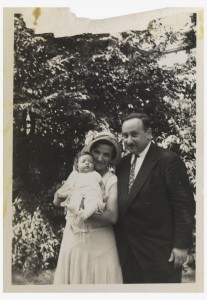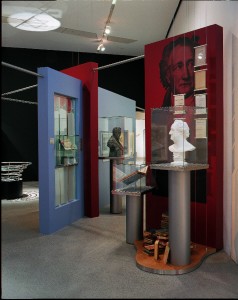
Excerpt from “The Guardian / Sycamore Group”
© Atalya Laufer
One of the works in our art vending machine is a booklet which provides an insight into the inner-workings of many of the Israeli Kibbuzim. With sober drawings and a text that is based on archival documents, artist Atalya Laufer (b. 1979) exposes a particular aspect of growing up on a Kibbutz. As one of the last generation of children to be raised in communal children’s houses (Batei Yeladim), she takes us on a journey through time and into the passing world of the Kibutzim.
The text in the booklet is based on protocols of night shifts that were taken in the early 1970s. In these protocols incidents and particularities in every house, during every night shift, had been recorded. Owing to these we can readily reconstruct the daily life in children’s houses. → continue reading

Gisela and Philipp Kozower with their daughter Eva in August of 1932
© Friends of the Jewish Museum New York, Princeton; photographer: unknown, donated by Klaus M. Zwilsky
Lawyer Philipp Kozower was 37 when he married the 23-year-old medical student Gisela in 1931. A year later she gave birth to their first child, a daughter called Eva. The new parents had their picture taken with their baby in Berlin’s Monbijou Park: wearing a bright dress and straw hat, Gisela holds the baby towards the camera somewhat awkwardly, as if the picture should document that Eva exists.
By the time Eva’s sister Alice was born in 1934, the National Socialists had already enacted numerous laws against Jews as well as taken measures to exclude them from public life. Our online project “1933: The beginning of the end of German Jewry” presents a variety of source materials from the Jewish Museum Berlin’s archives that bear witness to the disenfranchisement of German Jews. A display case with photographs and letters in our permanent exhibition details the Kozower family’s story: → continue reading
When you do a search of our library catalog for Goethe you could get this idea: 70 hits for works by or about the German poet (by contrast, Schiller only gets 16). And until a few years ago the impressive 1867 Cotta’schen edition of Goethe appeared in our permanent exhibition. Many people used to ask the visitor’s desk: “Was Goethe Jewish?” No, he wasn’t. But for many Jews he was the paragon of German culture, and his works symbolized membership in the German educated middle-class.

Former Goethe installation in the permanent exhibition
© Jewish Museum Berlin, photo: Marion Roßner
A few months ago, the Richard M. Meyer Foundation gave us more than 100 books by and about Richard M. Meyer himself. The son of a banker, art collector, and man of letters was a Goethe scholar. Meyer never acquired a proper professorship, but his 1895 biography of Goethe won awards and was published again and again – as a single volume, in multiple volumes, as a people’s edition and a reserved edition. According to the biography, Goethe saw “nationalities merely as transitional forms” (Volksausgabe [People’s Edition] 1913, p. 352). Statements like this illustrate the dilemma of German-Jewish assimilation during that period. If a Jewish reader of Goethe placed the poet’s cosmopolitanism in the foreground, he exposed himself to the accusation of misunderstanding the German essence of his writings. But when he explicitly recognized just this quality in Goethe’s language, his very right to have a say was contested. → continue reading


